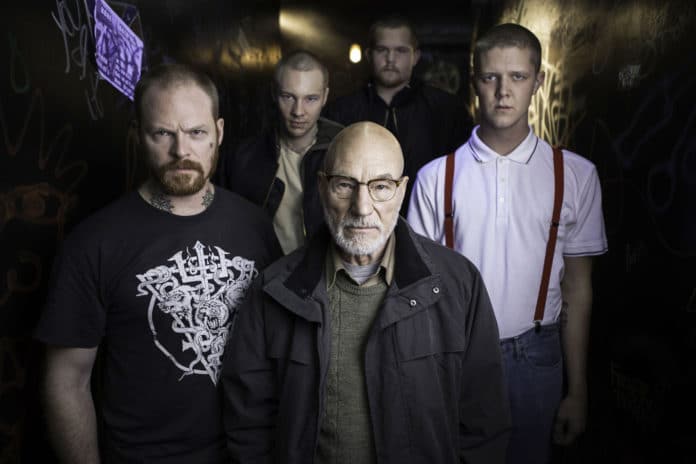If the experience of watching “Green Room” feels like getting knocked around the world’s nastiest mosh pit, that’s entirely by design. You don’t know what chaotic violence is coming next.
The frontman of this bracing new horror-thriller, writer-director Jeremy Saulnier, strands a punk quartet in a backwoods club run by white supremacists. After witnessing a murder, the band is engulfed in a desperate fight to the death against machete-wielding skinheads who have them vastly outnumbered.
“I know a lot of filmmakers who try to make quote-unquote ‘punk’ movies,” said Saulnier, stopping through Chicago on a publicity tour that also tends to confine him to one building, albeit under less stressful circumstances. “But most bog themselves down in ideology and punk references left and right. (‘Green Room’) is about taking the energy, aesthetic and propulsive qualities of the music and using them in support of a genre siege thriller.”
As an 8-year-old skateboarder growing up in Alexandria, Virginia, Saulnier, now 39, remembers glomming onto the older kids who’d bring their boomboxes to the skate park, making punk and new wave music the background noise of his childhood. He was introduced to punk in 1985, via the Dead Kennedys’ seminal album “Fresh Fruit for Rotting Vegetables,” and he would ask his mother to take him to the record store to buy the LPs.
“Often I’d hate them,” Saulnier said. “It was about trying to be cool. But I’ve always associated punk and hard-core with physical expression. That was skateboarding.”
When Saulnier reached his teens, in the early ’90s, the D.C. punk/hard-core scene was still flourishing under the influence of Dischord Records and its founder, Ian MacKaye, whose bands Minor Threat and Fugazi had established the city as a wellspring for the movement. Saulnier fondly recalls his time in the trenches (“I liked to get into the pit, but I wasn’t particularly tough”), and the motley assortment of attendees, from kids in letterman jackets to Nazi skinheads.
Saulnier was also once a “yeller” (or lead singer) for the Alexandria hard-core band called No Turn on Fred – a reference to all the nearby “No Turn on Red” traffic signs that had Fs spray-painted in front of the “Red,” he remembers. “This tribute to local vandals became too hard to explain, so we later went by ‘N.T.O.F.” and called it a day.”
Brooke and Will Blair – siblings of his childhood friend and closest collaborator, Macon Blair – have converted the noise of Saulnier’s youth into a more sophisticated ambient score.
Other memories of the scene serve as genetic material for “Green Room,” which thrives on the dangerous chemistry between mismatched tribes.
“Once in a while there would be some brawls,” Saulnier said. “But the Nazi punks would often be the victims of violence more than the aggressors, because they were not the majority. I remember as a teenager there was a stabbing outside the club, and they shut it down. I had to walk through the blood spatter on the way out of the venue. I wasn’t in any actual danger, but it stuck with me.”
Saulnier currently lives in Brooklyn, where he has served as cinematographer to other indie borough-dwellers like Matt Porterfield (“Putty Hill”) and Michael Tully (“Septien”). Two years ago, Saulnier scored a minor hit with his directorial debut, “Blue Ruin,” a superb Coen brothers-inspired thriller about a hapless amateur (Macon Blair) on a quest for revenge. Saulnier gambled his career and much of his own money on that film, and although “Green Room” doesn’t have the same personal stakes, it has no trouble summoning the same urgency and old-school genre chops.
Informed in equal parts by Saulnier’s past and classic siege thrillers like John Carpenter’s “Assault on Precinct 13” and Sam Peckinpah’s “Straw Dogs,” “Green Room” opens with the Ain’t Rights, a punk outfit, sputtering their way through the Pacific Northwest. After their latest gig nets them less than $10 each at the door, the band (Anton Yelchin, Alia Shawkat, Joe Cole and Callum Turner) agrees to take a lucrative bill at a skinhead venue whose proprietor is played, in a minor casting coup, by Patrick Stewart. The Ain’t Rights are eager to bail as soon as the set is over, but after they stumble onto a murder, the skinheads will not let them leave.
The nuts and bolts of “Green Room” could not be more basic: The Ain’t Rights, along with another witness (Imogen Poots), want to get out of the bar, but they have to run a gantlet of white-power goons to do it. And when they try, the film erupts into startling spasms of graphic violence, which Saulnier intends to reflect “the awkward, brutal, sloppy” nature of the real thing. For him, the film is about “showing up” and feeling the intensity of a live event, whether it’s the volatility of an Ain’t Rights set or the full terror of watching them fight for their lives. Just as you can’t really understand punk music without the physical experience of being there, “Green Room” promises moviegoers an in-the-moment, visceral punch.
“Hopefully it will affect the involuntary nervous system in a way that you lose control,” Saulnier said, “and you feel this elation when you survive the whole ride. You can’t take ‘Green Room’ and make a limited-episode TV series out of it. You have to show up at the theater and be part of a collective experience.”
With “Green Room,” Saulnier is keenly aware that he’s made an analog movie for a digital age. In one self-conscious moment, the Ain’t Rights talk about eschewing the modern-day promotion of social media, even if it means relegating themselves to obscurity. Released by the innovative distributor A24, which put out the similarly idiosyncratic horror movie “The Witch” earlier this year, “Green Room” isn’t so defiant about promotion, but there’s no obvious market for a throwback to a time when modest, two-fisted thrillers like “Assault on Precinct 13” could make a quick buck. It’s too rough for the arthouse, too raw for the multiplex.
While Saulnier hopes “Green Room” will succeed by channeling the immediacy of an ’80s D.C. punk show, his technique is more sophisticated than it seems. He may not be playing the audience like a piano, as Alfred Hitchcock famously claimed, but the discordant notes he does hit are calculated to similar effect.
“I think we have a far more intense film than any of these superhero franchises,” Saulnier said. “You can blow up a thousand cities in a spaceship, but I firmly believe that when you have intense small-scale violence, you can ratchet it up tenfold and it will have a bigger impact than any sort of planetary destruction.”








